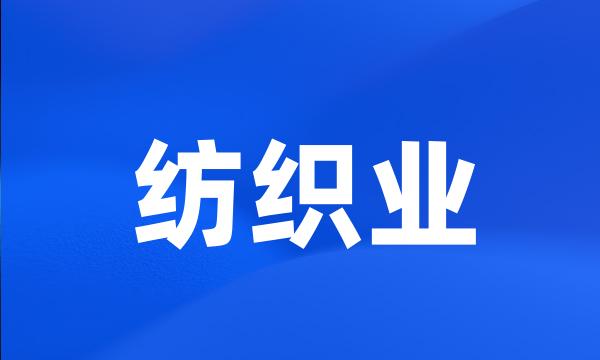纺织业
- 名textile industry
 纺织业
纺织业-
有关纺织业的更多评论请参看下面第7章。
See Chapter 7 below for further comments on the textile industry .
-
他们在纺织业大获成功后搬了进来,并帮助了希尔弗森一个庞大的纺织业。
They moved in after big success in the textile industry and aided a substantial textile industry in Hilversum .
-
纺织业对于致力于工业化的国家来说是个比较稳妥的产业。
Textiles are a good bet for a country bent on industrialisation
-
但纺织业的繁荣只持续了几十年。
But the textile boom lasted only several decades .
-
对荷兰人来说,希尔弗瑟姆的一切都与纺织业、传媒业和现代建筑有关。
For Dutch people , Hilversum is all about textileand media industries , and modern architecture .
-
WTO对绍兴市纺织业的影响及对策
WTO 's Influence on Textile Industry of Shaoxing City and Its Countermeasures
-
WTO下中国纺织业如何应对反倾销
How Can the Textile Industry of China Deal With Anti-dumping Under WTO Circumstances
-
基于VPN和多层次Web结构的纺织业ERP集成系统的设计
Spinning Enterprises ERP Integrated System Based on VPN and Multi-Tier Web
-
西部大开发和WTO新形势下甘肃纺织业的发展战略研究
Strategic Researches on Gansu Textile Industry in the Situation of West Development and WTO
-
基于分布计算技术的纺织业CRM的研究和应用
Researched on Application of CRM for Textile Enterprise Based on Distributed Computing Technology
-
加入WTO以后,我国纺织品出口规模持续扩大,纺织业的国际竞争力及国际分工地位不断提高。
After entering into WTO , textile export quantity of our country enlarge continually , international competition and international status rise constantly .
-
香港纺织业联会(HongKongTextileCouncil)副会长林宣武(WillyLin)补充道:客户纷纷要求我们延迟1月份的发货。
Willy Lin , vice-chairman of the Hong Kong Textile Council , adds : Customers are asking us to delay January shipments .
-
这对长期置于配额管制之下,缺乏在WTO框架内处理贸易争端的我国纺织业无疑是重大打击。
It has badly affected China 's textile industry , which had long been under the regulation of quota system and is lack of the experience to deal with trade affairs in WTO .
-
这位用户称,雾霾增加了口罩消费和医疗费用,促进了纺织业和棉花种植,对GDP做出了贡献。
' Smog has increased the consumption of face masks and hospital bills , it promotes the textiles industry and cotton planting , contributing to national GDP , ' the user said .
-
本论文主要探讨是否在纺织业和食品业存在FDI的水平关联、前向关联和后向关联而产生的技术溢出。
The aim of this paper is to determine whether there are potential FDI spillovers through horizontal , backward and forward linkages for the textile and foodstuff sectors of the Chinese economy .
-
加入WTO既给我国纺织业带来良好的发展机遇,也促使产业结构进行相应的调整,而与产业经济息息相关的职业教育,亦需进行相应的改革。
Entering the WTO brings a good opportunity for the development of the textile industry in China , and urges the adjustment of the industrial structure . The vocational education closely linked with the industrial economy has to be correspondingly reformed .
-
加入WTO后,我国纺织业和纺织企业进入了一个新的发展阶段,既面临前所未有的发展机遇,但也遭受到各种新的竞争压力。
After entering WTO , the spinning and weaving industry and the business enterprise in our country enter in a new development time : they not just face the unprecedented development opportunity , but also suffer all kind of new competitive pressure .
-
同时也讨论了网络化制造与ASP服务的标准化体系建设以及服装纺织业和机械制造业为代表的制造行业ASP平台实现模式、应用模式和商务模式等相关技术。
At the same time also discussed the network manufacturing and ASP services standardization system for textiles and clothing as well as construction machinery manufacturing industry represented by the manufacturing industries ASP platform model , application model and the business model , and other related technologies .
-
随着2005年1月1日《纺织品服装协定》(ATC)的终止,世界纺织业迎来了自由贸易的时代,配额的取消,对各个纺织出口国来说,既是机遇,也是挑战。
With the termination of the Agreement on Textile and Clothes ( ATC ), trade in textile and clothing enters into an era of free trade . It is both an opportunity and a challenge for every fabric country .
-
SA8000是继绿色贸易壁垒之后一种新型的非关税壁垒。SA8000是一把双刃剑,一方面削弱了我国纺织业的比较优势地位,另一方面又优化了市场竞争环境。
SA8000 is a new non-tariff trade barrier following the green trade barriers , which is a double edged sword that , on one hand , weakens the relatively advantageous position of China 's textile industry , and , on the other hand , also optimizes the environment of competition .
-
EIU的研究显示,虽然中国纺织业正以每年6%的速度萎缩,但就电脑产品和有附加值的产品而言,中国仍然是制造业中心,而总体的零售业和服务业就更不用说了。
While EIU research showed that the textile sector in China was shrinking at an annual rate of 6 per cent a year , China remains the hub for manufacturing of computer products and value-added goods , not to mention retail and services in general .
-
新汇率制度下中国纺织业的应对及发展
Textile industry 's response and development under new exchange rate system
-
世界纺织业者对北美自由贸易协定的反应
World Textile Producers ' Response to North America Free Trade Agreement
-
欧洲共同市场纺织业协调委员会
Coordination Committee for the Textile Industries in the European Common Market
-
中国对东盟纺织业投资的经济效应分析
The Economic Effect Analysis of China Textile Industry Investment to ASEAN
-
纺织业发展循环经济的特点和主要领域
Features and major areas of the textile industry developing circular economy
-
后配额时代的我国纺织业发展出路
Our Country Textile Enterprise 's Outlet in After The Quote Time
-
第三是棉纺织业的从业人数(即纺织户)的估计。
Third cotton textile industry workers ( i.e. textile households ) estimation .
-
中国纺织业布局和结构分析
An Analysis of Layout and Structure of Chinese Textile Industry
-
中国纺织业,积极出击
The textile Industry of China should launch an attack actively
